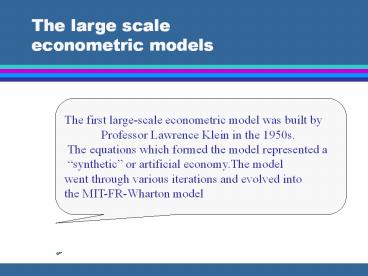The large scale econometric models - PowerPoint PPT Presentation
Title:
The large scale econometric models
Description:
The large scale. econometric models. The first large-scale econometric model was built by ... Yt = Ct It Gt Xt Mt [5.5] ... – PowerPoint PPT presentation
Number of Views:57
Avg rating:3.0/5.0
Title: The large scale econometric models
1
The large scale econometric models
The first large-scale econometric model was built
by Professor Lawrence Klein in the 1950s. The
equations which formed the model represented a
synthetic or artificial economy.The modelwent
through various iterations and evolved into the
MIT-FR-Wharton model
2
Uses of the model
- Using this model, it was possible to simulate the
effects of proposed fiscal policy measures such
as increased military spending and tax cuts on a
wide array of aggregate (Y, I, C, S, ...) and
disaggregate level variables (truck sales,
employment in construction trades, cement
prices). - For example, The people who ran the model were
asked to simulate the impact of the proposed
Kennedy-Johnson tax cuts in the early 60s (took
effect in 1964) on a broad array of economic
variables.
3
A simple macro model
Consider the following economy
Yt Ct It Gt Xt Mt 5.5
Equation 5.5 can be read as follows Total
output in period t is equal to total spending for
new goods and services in period t , or
consumption plus investment plus government
expenditure plus imports minus exports.
Equation 5.5 is an identitythat is, it is true
by definition
4
The behavioral equations
Ct a b(Yt Tt) dPt 1
5.6 Tt e fYt
5.7 It h jYt 1 kRt
5.8 Mt n qYt
5.9 Pt s uYt
vPt 1
5.10
We call these behavioral equations because they
describe the way the way the spending category
has behaved in the past as a function of the
explanatory variables.
5
Finding the reduced form
First, we substitute the behavioral equations
5.6 through 5.10 into 5.5 to obtain the
following (we have dropped the t subscripts to
economize on notation)
Y a b(Y e fY) dPt 1 (h jYt-1
kR) G X (n qY)
By rearranging this equation, we obtain the
following reduced form equation
5.11
6
Exogenous and endogenous variables
- Exogenous variables are determined outside the
model. They may be know by forecastersor
forecasters may have to forecast them In
our model X, G, and R - Endogenous variables are determined within the
modelspecifically, by equation 5.11 In our
model Y, C, I, T, M, and P
7
Forecasting using the reduced form
- The forecaster can estimate the values of a, b,
d, e, f, h, j, k, n, q, s, u, and v with time
series regression analysis. - Pt 1 and Yt 1 are known
- That leaves the exogenous variables Gt, Xt, and
Rt. Perhaps Gt is known. The forecaster will have
to estimate (forecast) the values of the other
exogenous variables
8
The Suits modela
The article is noteworthybecause is
educatedeconomists on the newapplications of
econometrics made possible by advances in
computer technology
Y C I G (1) C 20
0.7(Y - T) (2) I 2 .01Yt - 1
(3) T 0.2Y (4)
- The unkown variables are Y, C, I, and T
- The known variables are G and Yt - 1.
aDaniel Suits. Forecasting and Analysis with an
Econometric Model, American Economic Review,
March 1962 104-132.
9
A simple national econometric model a
Consider a closed economy with government
GDP C I G
GDP is the dependent variable.Hence, to get
solution for GDP, we mustfirst specify and
estimate models for C, I, and G
a The following is based on A. Migliario. The
National Econometric Model A Laymans Guide,
Graceway Publishing, 1987.
10
The aggregate level specifications
GDP t 1 C t 1 I t 1 G t 1
(2) C t 1 ?1 ?2DYt et
(3) I t 1 ?3 ?4it et
(4) G t 1 ?5 ?6Gt b
(5)
- Migliaro used OLS to estimated ?1, ?2, ?3, ?4,
?5, and ?6 - Having accomplished that, he substituted
estimated equations (3), (4), and (5) back into
(2) to get a forecasted value of G t 1. - An example I t 1 11.567 - 0.419it
b Migliaro used the trend component to forecast
G.
11
Extending (disaggregating) the model
Let C t 1 DUR t 1 NONDUR t 1
SERVICES t 1
Now let DUR t 1 AUTOS t 1 FURNITURE t
1 APPLIANCES t 1 . . .
Now letAUTOS t 1 Passenger Cars t 1
Vans t 1 Trucks t 1 . . .
12
A trucks specification
Trucks t 1 ?1 ?2DYt ?3AGEt ?4PRICEt et
- As we increase the level of disaggregation, we
increase the number of equations.That is, we
could have equations for different classes of
trucks--midsize, etc. - It is the disaggregate level forecasts which are
most valuable tobusiness decision-makers. - Entities such as DRI-McGraw Hill and Chase
econometrics sell disaggregate-level forecasts to
a high-powered client base.
13
A lot of equations
- The DRI-McGraw Hill Model has approximately 450
equations. - The FRB-MIT-Wharton model has 669 equations.
- The Chase Econometrics modle has 350 equations
- The Kent model has 44,400 equations.































